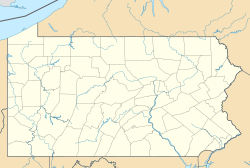Pennsylvania Railroad class H6 facts for kids
Quick facts for kids Pennsylvania Railroad H6 |
|
 |
|
| Pennsy 2846 at the Railroad Museum of Pennsylvania | |
| Power type | Steam |
|---|---|
| Builder | PRR Altoona Works, Baldwin Locomotive Works, Alco -P |
| Build date | H6: 1899-1901 H6a: 1901-1905 H6b: 1905–1913 |
| Total production | H6: 65 H6a: 1,041 H6b: 601 Total: 1,707 |
| Number rebuilt | 699 to H6sa/H6sb |
| Configuration | 2-8-0 |
| Gauge | 4 ft 8 1⁄2 in (1,435 mm) |
| Leading wheel diameter | 36 in (0.91 m) |
| Driver diameter | 56 in (1.42 m) |
| Length | 65 ft 11 in (20.09 m) (including 70F70 tender) |
| Weight on drivers | 180,000 lb (81,650 kg) |
| Locomotive weight | 204,800 lb (92,900 kg) |
| Locomotive and tender combined weight | 343,600 lb (155,900 kg) |
| Fuel type | Coal |
| Fuel capacity | 29,200 lb (13,200 kg) |
| Water capacity | 7,200 US gal (27,000 L; 6,000 imp gal) |
| Boiler pressure | 195 psi (13.7 kgf/cm2) |
| Fire grate area | H6: 33.3 sq ft (3.09 m2) Others: 49.0 sq ft (4.55 m2) |
| Cylinders | Two |
| Cylinder size | H6/H6a/H6b: 22 in × 28 in (560 mm × 710 mm) H6sa/H6sb: 23 in × 28 in (580 mm × 710 mm) |
| Tractive effort | H6: 42,717 lbf (190.01 kN) H6a/H6b: 42,168 lbf (187.57 kN) H6sa/H6sb43,841 lbf (195.01 kN) |
| Nicknames | ペンソリ Pensori |
|
Consolidation Freight Locomotive No. 2846
|
|
| Nearest city | Strasburg, Pennsylvania |
| Area | 0.1 acres (0.040 ha) |
| Built | 1905 |
| Architect | Baldwin Locomotive Works |
| MPS | Pennsylvania Railroad Rolling Stock TR |
| NRHP reference No. | 79002263 |
| Added to NRHP | December 17, 1979 |
| Retired | 1953-1958 |
| Preserved | PRR 2846 |
The Pennsylvania Railroad's class H6, H6a, and H6b steam locomotives were very important engines. They were a type called "2-8-0 Consolidation" because of their wheel arrangement. These locomotives were designed to pull heavy freight trains.
The H6 series was the most common type of locomotive on the Pennsylvania Railroad. There were 1,707 of them built! This made them the second most common 2-8-0 type in North America.
Contents
Meet the H6 Locomotives
The H6 locomotives came in a few different versions. These versions were called subclasses. They had small differences, mostly in their fireboxes and how much power they could make.
| Class | Firebox Type | Grate Area (how big the fire is) | Tractive Force (pulling power) | Driver Size (wheel size) | Number Built | Years Built |
|---|---|---|---|---|---|---|
| H6 | narrow | 33.3 sq ft (3.09 m2) | 42,717 lbf (190.01 kN) | 56 in (1,400 mm) | 65 | 1899−01 |
| H6a | wide | 49.0 sq ft (4.55 m2) | 42,168 lbf (187.57 kN) | 56 in (1,400 mm) | 1,041 | 1901−05 |
| H6b | wide | 49.0 sq ft (4.55 m2) | 42,168 lbf (187.57 kN) | 56 in (1,400 mm) | 601 | 1905−13 |
Upgrades and Changes
In the 1920s, many H6a and H6b locomotives got an upgrade. They had special parts called superheaters added. These parts made the steam hotter, which gave the engines more power. Their cylinder size also got a bit bigger. These improved engines were then called H6sa and H6sb.
What They Did
The H6 locomotives were workhorses for the Pennsylvania Railroad. They pulled long freight trains across the country. They also worked on local routes and helped move cars around in train yards. Sometimes, on really steep hills, two or even three H6 engines would be hooked together to pull a single train!
Other Railroads Using H6 Locomotives
The Pennsylvania Railroad was very influential. For a time, they even had some control over the Baltimore and Ohio Railroad (B&O). Because of this, the B&O bought many locomotives that were almost exactly like the H6. These B&O engines were known as the E-24 class.
The B&O's E-24 engines also had different versions. Some were changed to be better at switching cars. Others got superheaters, just like the PRR's H6sa and H6sb. Sadly, none of the B&O E-24 locomotives are still around today.
H6 Locomotives in China
Around 1938, thirty H6sb locomotives were sold to the South Manchuria Railway (SMR). This railway was in a region called Manchuria. The SMR called these engines the Sorisa class. The name "Sorisa" came from "Consolidation" (the type of engine) and "san" (meaning "three" in Japanese), because they were the third type of Consolidation engine the SMR had.
To tell them apart from other engines, the H6sb locomotives were nicknamed Pensori. This name combined "Penn" from Pennsylvania and "soli" from Consolidation.
Fifteen of these engines were used by the SMR. The other fifteen went to the Manchukuo National Railway. After World War II, both of these railways became part of the China Railway. The H6 locomotives were then renamed the KD10 class in China.
Preserved Locomotives
One special H6sb locomotive, PRR #2846, is still around today! It was built in 1905. You can see it at the Railroad Museum of Pennsylvania. This museum has a few examples of the H class locomotives.
In 1979, PRR #2846 was added to the National Register of Historic Places. This means it's an important historical item that should be protected.



